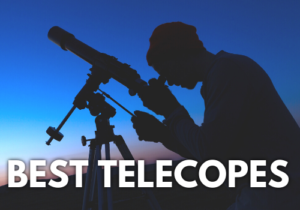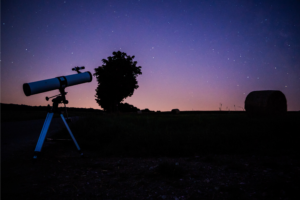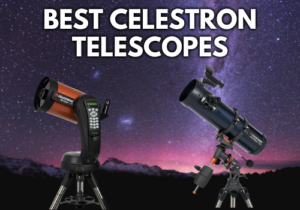7 Best Telescopes Under $150; Reviews
Disclosure: This post contains affiliate links and I may earn a small commission (at no extra cost to you) if you click through and make a purchase. Thanks in advance – I really appreciate it!
Looking for the best telescope under $150, and not sure where to start? You’ve come to the right place! The most important thing to know is that the best telescope for you is the one that you will use and have fun with.
The $150 price point is certainly sufficient to try out whether you’re interested in astronomy, enjoy views of the moon, and also have an extremely portable option to bird watch or take it camping or hiking.
All the telescopes on this list are budget-friendly and cost less than 150 dollars. While they obviously won’t be as powerful or even as high-quality as more expensive telescopes (which can range from $300 to $3000!), they’ll get you oriented to how telescopes work.
Best Telescopes Under $150
Comparison Table
| Image | Title | Price | Buy |
|---|---|---|---|
 | Celestron - AstroMaster 70AZ Telescope - Refractor Telescope - Fully Coated Glass Optics - Adjustable Height Tripod – Bonus Astronomy Software Package | See on Amazon | |
 | Gskyer Telescope, 70mm Aperture 400mm AZ Mount Astronomical Refracting Telescope for Kids Beginners - Travel Telescope with Carry Bag, Phone Adapter and Wireless Remote | See on Amazon | |
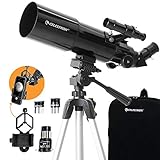 | Celestron - 80mm Travel Scope - Portable Refractor Telescope - Fully-Coated Glass Optics - Ideal Telescope for Beginners - Bonus Astronomy Software Package - Digiscoping Smartphone Adapter | See on Amazon | |
 | Orion SpaceProbe II 76mm Altazimuth Reflector Telescope | See on Amazon | |
 | Maksutov-Cassegrain Telescope for Adults Kids Astronomy Beginners, Sarblue Mak60 Catadioptric Compound Telescope 750x60mm, Compact Portable Travel Telescope, with Tabletop Tripod Phone Adapter | See on Amazon | |
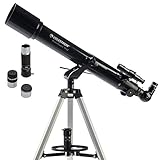 | Celestron - PowerSeeker 70AZ Telescope - Manual Alt-Azimuth Telescope for Beginners - Compact and Portable - BONUS Astronomy Software Package - 70mm Aperture | See on Amazon | |
 | Orion Observer 70mm II AZ Refractor | See on Amazon |
Product prices and availability are accurate as of the date/time indicated and are subject to change. Any price and availability information displayed on [relevant Amazon Site(s), as applicable] at the time of purchase will apply to the purchase of this product.
Prices pulled from the Amazon Product Advertising API on:What to expect from a telescope under $150?
Believe it or not, telescopes that cost less than 150 dollars are quite capable too.
But keep in mind that the image won’t be as pristine as high-priced models.
Manufacturers do have to cut corners and leave out some features to keep costs low. Generally, these units are considered to be entry-level options.
So, you’re not going to get massive magnification levels or ultra-wide apertures. You can still get a clear image and a pretty decent performance.
Don’t be surprised to find a lot of plastic parts – it’s a compromise for the cost savings. You’ll see it around the mount and tripod, but you don’t want to see it in the optics. No plastic objective lenses are allowed.
Many of the accessories may be plastic as well, but if you can secure good optical quality with real glass and mirrors, you’ll be okay – accessories can be replaced later.
What can you see with a telescope under $150?
Since these telescopes are built with beginners in mind, you should be able to see all the basics without any issues.
The telescopes on this list will show you Mercury and Venus’ phases, lots of detail on the Moon, Jupiter’s cloud belts, moons, and maybe the Great Red Spot.
You can also expect to see Saturn’s rings and the Cassini division in them, and if it’s a steady night you can also see Saturn’s moon Titan and possibly a few other moons such as Rhea and Dione.
Uranus and Neptune are way too far to be seen clearly even with powerful telescopes. If you can see them in the first place, they will appear as tiny bluish dots through a telescope for under $150, and they will be difficult to distinguish from the stars.
Outside the solar system, the small aperture of these telescopes limits you to a handful of deep-sky objects such as the Orion Nebula, some open clusters such as the Double Cluster and M35, and the Ring Nebula.
There are also countless double stars to explore if you’re into that. Frankly, the telescopes in this price range are simply too small to show you a lot of deep-sky objects.
Can you indulge in astrophotography with telescopes that cost less than $150?
For astrophotography, you will need a telescope with a strong equatorial mount that can sustain the weight of the camera.
Unfortunately, the telescopes that cost less than $150 mostly come with Alt-az mounts that are not very strong or robust. So you can not use these telescopes for professional astrophotography.
However, many of the telescopes reviewed in this article come with smartphone adapters. You can use these adapters to mount your iPhone or Android device on the telescope to take beautiful pictures of the moon and planets.
Moreover, during the daytime, the refractor telescopes on this list can also be used as terrestrial telescopes to take pictures of wildlife, nature, oceans, and lakes.
Top Telescopes Under $150
1. Celestron - AstroMaster 70AZ
- High-quality 70mm optics: Our Celestron telescope features a powerful, fully coated 70mm glass optic objective lens. Erect image optics allow you to observe celestial objects at night and terrestrial targets like wildlife and landscapes during the day.
- Quick setup & lightweight frame
- Included accessories: We’ve included 2 eyepieces (20mm and 10mm), an erect image star diagonal, a travel tripod, and a red dot finder scope. Download our BONUS Starry Night Basic Edition astronomy software for interactive sky simulati
Prices pulled from the Amazon Product Advertising API on:
Product prices and availability are accurate as of the date/time indicated and are subject to change. Any price and availability information displayed on [relevant Amazon Site(s), as applicable] at the time of purchase will apply to the purchase of this product.
Specifications
- Type: Refractor
- Aperture: 70mm (2.8″)
- Focal length: 900mm
- Focal Ratio: f/13
- Mount: Alt-Azimuth
- Eyepiece: 20mm,10mm
- Magnification: 45x, 90x
- Weight: 11.0 lbs (5.0 kg)
With 70mm aperture and mounted on an altazimuth mount. It’s an entry-level telescope that costs less than $150 and has several nice features that make it a great option for the beginner astronomer.
With this telescope, you’ll be treated to crisp and sharp images of many of the solar system’s showpiece objects, including the moon, bright stars, and large planets.
The Celestron AstroMaster 70AZ offers a 70mm (2.75”) aperture refractor, and the lens is set in a long tube giving a focal length of 900mm, which gives good color clarity by pretty much eliminating chromatic aberration.
The crown and flint glass used in this telescope is fully coated to provide good light transmission and clear, crisp imaging.
You can read the Celestron AstroMaster 70AZ full review here.
Why We Recommend It
This 70mm refractor is good enough to show you the brightest objects in the solar system. With an f/13 focal ratio, it is perfect for focusing on the planets and the moon and comes with enough power to view both.
It is lightweight and durable which makes it great as a scope that you can take with you on your hiking or camping trip. It requires little experience, little worry, and little hassle to operate.
It can also be used during the daytime as a terrestrial telescope. That means in addition to getting great views of the moon and Jupiter you can also use it to get stunning views of distant mountain peaks, deep canyons, or lush valleys.
The design of the Celestron Astromaster LT 70AZ is very simple. There are no complicated parts or accessories. There is nothing explicitly fragile or worrying and it is not very expensive.
Pros
- Great value for money
- Comes with fully coated professional lenses
- Can also be used for terrestrial viewing
- Perfect for beginners and kids
- Requires no tool to setup
- Easy to use
Cons
- Not the steadiest mount
- Not much magnification power
2. Gskyer 70mm Refractor Telescope
- Quality Optics: 400mm(f/5.7) focal length and 70mm aperture, fully coated optics glass lens with high transmission coatings creates stunning images and protect your eyes. Perfect telescope for astronomers to explore stars and moon.
- Magnification: Come with two replaceable eyepieces and one 3x Barlow lens.3x Barlow lens trebles the magnifying power of each eyepiece. 5x24 finder scope with mounting bracket and cross-hair lines inside make locating objects easily.
- Wireless Remote: Free includes one smart phone adapter and one Wireless camera remote.
- Adjustable tripod and a carry bag,
- Satisfaction: TWO-YEAR warranty. And technical support from our team of experts in 24 hou
Prices pulled from the Amazon Product Advertising API on:
Product prices and availability are accurate as of the date/time indicated and are subject to change. Any price and availability information displayed on [relevant Amazon Site(s), as applicable] at the time of purchase will apply to the purchase of this product.
Specifications
- Type: Refractor
- Aperture: 70mm (2.75″)
- Focal length: 400mm
- Focal Ratio: f/5.7
- Mount: Alt-Azimuth
- Eyepiece: 25mm, 10mm
- Magnification: 16x, 40x
- Weight: 5.3 lbs.(2.4 kg)
The Gskyer’s AZ70400 Telescope is a 70mm aperture and 400mm short focal length refractor telescope mounted on a camera-type tripod.
It includes a 45-degree diagonal, a carry case, finder scope, two eyepieces, a 3x Barlow lens, and a smartphone adapter which you can use to mount your smartphone to take pictures of the night sky or wildlife and nature during the day.
With a basic, fluid, altazimuth mount, this telescope is super easy to use.
You won’t have to worry about your kids knocking this scope over or being frustrated with its use.
It is a great scope for introducing your kids to astronomy or using it as a fun family activity.
The eyepieces are decent Kellner’s. They have 10mm and 25mm apertures. Although the 10mm eyepiece provides a little too much power(40x), the 25mm eyepiece(16x) is usable.
The 45-degree diagonal is provided to be used for terrestrial use. But, if the object you are trying to observe is a little high from the horizon, it becomes harder to look through the eyepiece, and you may have to bend over.
Why We Recommend It
With a 70mm aperture, this Gskyer 70mm Telescope does not have a ton of viewing power.
You can still see all of the best solar system views including great images of the moon and Saturn, and good images of Jupiter and Mars.
It can see your favorite constellations with relative ease and is able to hone in on some other favorites like Andromeda.
The accessories included with this telescope are a handy carrying bag, finderscope, zenith mirror, two eyepieces (10mm and 25mm), a 3x Barlow lens which triples the effectiveness of the two eyepieces, a smartphone attachment that allows for basic pictures of the night sky and a tripod.
Pros
- Easy to set up and use
- Very portable
- Perfect for beginners and family
- Decent optics
- Comes with its own backpack
- Robust design
Cons
- Instruction manual is a bit vague
- Difficult to collimate
3. Celestron - 80mm Travel Scope
- SUPERIOR OPTICS: The Celestron 80mm Travel Scope features high-quality, fully-coated glass optics, a potent 80mm objective lens, a lightweight frame, and a custom backpack to carry it all. Its quality is unmatched in its class and against competitors.
- POWERFUL EYEPIECES FOR UP-CLOSE VIEWING: Our telescope for astronomy beginners is equipped with two high-quality eyepieces (20mm and 10mm) that provide low- and high-power views of celestial objects at night and terrestrial objects during the day.
- BONUS BAG, TRIPOD, SMARTPHONE ADAPTER AND SOFTW
Prices pulled from the Amazon Product Advertising API on:
Product prices and availability are accurate as of the date/time indicated and are subject to change. Any price and availability information displayed on [relevant Amazon Site(s), as applicable] at the time of purchase will apply to the purchase of this product.
Specifications
- Type: Refractor
- Aperture: 80mm (3.15″)
- Focal length: 400mm
- Focal Ratio: f/5
- Mount: Alt-Azimuth
- Eyepiece: 20mm, 10mm
- Magnification: 20x, 40x
- Weight: 6 lbs.(2.5 kg)
The Celestron Travel Scope 80mm f/5 AZ Refractor Telescope Kit is designed for portability and ease of use for both astronomical and terrestrial use.
Its refractor-style optical tube has a respectable aperture that gathers the amount of light required to ensure views of the moon and planets remain bright and clear.
Included with this telescope is a universal smartphone adapter that lets you capture photos and videos through the eyepieces for easy editing, enjoyment, and sharing.
The Celestron travel scope comes with a backpack, and all the components and accessories along with the tripod and the telescope itself fit perfectly.
Why We Recommend It
This scope is perfect for you if you are looking to track the phases of the Moon, or if you want to hike up a hill during the day and then look at Jupiter’s rings after nightfall.
This amazing telescope costs under $150 and comes with two eyepieces, one has a focal length of 20mm, the other is a 10mm eyepiece.
Respectively, these deliver magnifications of 20x and 40x, which is fine for observing craters on the Moon or the Saturn’s ring and Jupiter’s Great Red Spot.
The tripod is made out of aluminum, so it’s lightweight and portable, and it’s light enough to carry and move about quite easily.
It also comes with a copy of the Basic edition of Starry Nights astronomy software and the SkyPortal app, both of which are useful for planning what bright objects to look at and where to find them.
This telescope is capable of producing detailed views of the Moon’s larger features, and you’ll see the crescent of Venus and Mercury, the moons and bands of Jupiter, and the rings of Saturn with it.
But in terms of deep-sky objects, it’s limited by the 80mm small aperture still it can show you the brighter stars in the night sky.
Pros
- 80mm aperture is ideal for lunar and planetary viewing as well as terrestrial use
- Fast f/5 focal ratio ensures views remain bright
- Photo-style tripod
- Lightweight and durable aluminum legs
Cons
- Short optical tube
- Useless finderscope
4. Orion SpaceProbe II Reflector Telescope
- 76mm (3) aperture reflector telescope is large enough for wonderful views of the Moon, rings of Saturn, moons orbiting Jupiter, and even some brighter nebulas
- Stable altazimuth mount and tripod provides smooth motion in both altitude (up/down) and azimuth (left/right) axes of motion
- Included 25mm and 10mm Kellner eyepieces provide 28x and 70x magnification options right out of the box!
- Includes two 1.25 telescope eyepieces, red-dot reflex sight, 1.25 rack and pinion focuser, MoonMap 260 and m
Prices pulled from the Amazon Product Advertising API on:
Product prices and availability are accurate as of the date/time indicated and are subject to change. Any price and availability information displayed on [relevant Amazon Site(s), as applicable] at the time of purchase will apply to the purchase of this product.
Specifications
- Type: Reflector
- Aperture: 76mm (3″)
- Focal length: 700mm
- Focal Ratio: f/9.2
- Mount: Alt-Azimuth
- Eyepiece: 10mm, 25mm
- Magnification: 70x, 28x
- Weight: 7 lbs.(3 kg)
If you’re looking for a beginner telescope under $150 to kick-start the hobby of astronomy, look no further! This telescope and accessory bundle is ideal for young backyard astronomers who are just starting to explore the wonders of the night sky.
Built around a 76mm diameter primary mirror, the Orion SpaceProbe II 76 mm Altazimuth Reflector Telescope also gathers enough light to view Saturn’s rings, Jupiter’s moons, and the terrain of our own Moon’s surface, as well as some more exotic star clusters and distant nebulas.
The SpaceProbe focal length of 700mm (f/9.2) is long enough to provide magnification of 28x and 70x with the included Kellner Explorer II 25mm and 10mm eyepieces, respectively.
Why We Recommend It
This is a fantastic beginner telescope the whole family will enjoy that’s lightweight, easy to set up, and has a very affordable price tag.
The telescope is a 3-inch (76mm) f/9.2 (700mm focal length) reflector, which makes it easy to bring into the field. It also comes with an optical tube, equatorial mount, two 1.25-inch Kellner eyepieces, and a red-dot reflex sight, which is enough to get you started with the basics.
Its stable altazimuth mount and tripod provide smooth motion in both altitudes (up/down) and azimuth (left/right) axes of motion.
The included red-dot sight makes aiming the telescope nice and easy.
Following a simple alignment procedure that parents can help with, you can use the red-dot sight to accurately aim the SpaceProbe II 76mm telescope at objects in the sky like the Moon and bright planets.
It also comes with an Orion MoonMap 260 which can help you learn more about the lunar features you see in the telescope. It has locations and names of over 260 features on the Moon such as craters, mountains, valleys, “seas” and more.
Pros
- Perfect for beginners
- Lots of accessories
- Gives crisp views of the moon
- Comes with a Moon map
Cons
- Mount is a bit shaky
- Starfinder could be better
5. Sarblue Mak60
- 【Sharp Crystal-clear Views】This beginner telescope is much more powerful than it looks! Thanks to its Maksutov-Cassegrain design, high-precision fully multi-coated optical glass lens, both spherical and chromatic abberrations are minimized. It not only delivers vivid high-contrast images for daytime viewing such as birds and wildlife, but also enables astronomical exploration including Saturn, Jupiter, craters on the Moon, etc.
- 【See How It Works Inside】The ingenious design of the detachable lid reveals the internal construction of the telescope and helps you understand how it works. Make it an appealing educational kit for the young minds. But keep in mind not to touch the mirrors with your fingers and avoid making it dusty.
- 【Compact and Portable】
- 【Superior Eyepiece】The included high-quality 20mm eyepiece brings 37.5X magnification, providing high-power sharp views on distant objects.
Prices pulled from the Amazon Product Advertising API on:
Product prices and availability are accurate as of the date/time indicated and are subject to change. Any price and availability information displayed on [relevant Amazon Site(s), as applicable] at the time of purchase will apply to the purchase of this product.
Specifications
- Type: Maksutov-Cassegrain
- Aperture: 60mm(2.36″)
- Focal length: 750mm
- Eyepieces: 20mm
- Magnification: 37.5x
- Weight: 2.62 lbs. (1.18 kg)
The Sarblue 60mm is a compact budget telescope for kids and novices that costs under $150.
It has a long focal length, and it’s primarily optimized for the Moon, planets, and double stars, but will show you a few deep-sky objects too.
The detachable lid on top of this Maksutov-Cassegrain telescope displays the internal construction of the telescope and helps children and novices understand the fundamental working features of the telescopes, making it ideal for you if you have children at home.
Furthermore, while having a 750mm focal length, the tube length is only 200mm, making it easy to store or tote on your next family adventure for magnificent views of the night sky.
It also comes with a phone adapter, a tabletop tripod, and an erect-image diagonal.
Why We Recommend It
The telescope comes with a high-quality 20mm wide eyepiece which gives 37.5X magnification, providing high-power sharp views of distant objects.
The included phone adapter and erect-image diagonal make it very useful if you want to use the telescope for daytime activities such as birdwatching, or ocean viewing.
The Maksutov-Cassegrain design of the telescope with a long focal length means you can achieve high enough magnifications for planetary viewing.
You can see the moon, Jupiter, Galilean moons, and the Great Red Spot on Jupiter’s surface.
You can also enjoy great views of Saturn, its rings, and the Cassini Division too.
Pros
- Lightweight, and highly portable
- Great for smartphone astrophotography
- Decent optics for the price & size
- Can be used as a terrestrial spotting scope
- Makes a great tool for educational purposes
Cons
- Not much magnification
- Small aperture
6. Celestron - PowerSeeker 70AZ
- PERFECT BEGINNERS TELESCOPE
- MANUAL YOKE MOUNT: Navigate the sky with our refractor telescope. It features a yoke mount with a slow-motion altitude rod for smooth and accurate pointing. Adjust rod to desired position, then easily secure by tightening cross knob.
- COMPACT AND PORTABLE
- MULTIPLE ACCESSORIES: The Celestron PowerSeeker 70AZ Telescope features 2 eyepieces (20mm and 4mm), erect image diagonal, a finderscope, plus a 3x Barlow lens to triple the power of each. Accessories also include a FREE download of one of the top consumer rated astronomy software programs.
- UNBEATABLE WARRANTY AND CUSTOMER SUPPORT: Buy with confidence from the world’s telescope brand, based in California since 1960. You’ll also receive a 2-year warranty and unlimited access to technical support from our team of US-based exper
Prices pulled from the Amazon Product Advertising API on:
Product prices and availability are accurate as of the date/time indicated and are subject to change. Any price and availability information displayed on [relevant Amazon Site(s), as applicable] at the time of purchase will apply to the purchase of this product.
Specifications
- Type: Refractor
- Aperture: 70mm(2.8″)
- Focal length: 700mm
- Eyepieces: 20mm, 4mm
- Magnification: 45x, 175x
- Barlow lens: 3x
- Weight: 5.8 lbs. (2.63 kg)
The Celestron PowerSeeker 70AZ is a low-cost telescope designed to provide families, amateurs, and even children an appealing and affordable glimpse of the night sky for under $150.
It comes with a finderscope, 2 eyepieces (20mm, 4mm), 3x Barlow lens, an aluminum tripod with accessory tray, and the SkyX astronomy software.
The PowerSeeker 70AZ mount is an alt-azimuth fork design that works well for both terrestrial and astronomical purposes.
There are no slow-motion controls, but the mount’s tension can be adjusted via small knobs, which works well enough. The aluminum tripod legs are small and thin, but just adequate enough to support the whole scope.
The well-coated lenses sit inside a 700mm optical tube, which creates an f/10 ratio. For ultimate beginners, this may not mean much. In short, there aren’t any color defects around bright images. Color accuracy and sharpness are on point.
Why We Recommend It
The PowerSeeker’s usefulness as a beginner scope is amplified by its basic, but quality, magnification, and viewing features. For instance, it provides a 70mm aperture, a number of eyepieces, and a Barlow 3x, which triples the strength of the eyepieces and therefore improves the telescope’s viewing ability.
The Powerseeker’s technology allows it to be used to look at objects on earth around the scope, such as trees and landmarks, as well as celestial objects, such as the moon and planets.
The PowerSeeker 70AZ can show you the lunar surface in great detail. With its 70mm aperture, it can gather enough light to view Saturn’s rings and Jupiter’s moons. You may also see Mars as a red dot in ideal atmospheric conditions.
Pros
- Decent optics for the price
- Affordable
- Easy to set up and use
Cons
- Small aperture
- Mount could be better
7. Orion Observer 70mm II AZ Refractor
- 70mm (2.75) aperture and 700mm focal length telescope provides great views of bright night-sky objects such as star clusters and cloudy nebulas
- Ideal for observing the Moon, bright planets like Jupiter, Saturn and Mars, and bright star clusters
- The included altazimuth telescope mount provides smooth up/down and left/right panning motion, and the adjustable-height tripod helps make your viewing sessions comfortable
- Complete telescope comes with 25mm and 10mm 1.25 Kellner eyepieces, red-dot sight, 1.25 rack and pinion focuser, 90-degree star diagonal, and the Orion Moon Map
Prices pulled from the Amazon Product Advertising API on:
Product prices and availability are accurate as of the date/time indicated and are subject to change. Any price and availability information displayed on [relevant Amazon Site(s), as applicable] at the time of purchase will apply to the purchase of this product.
Specifications
- Type: Refractor
- Aperture: 70mm(2.8″)
- Focal length: 700mm
- Eyepieces: 20mm, 10mm
- Magnification: 28x, 70x
- Mount: Al-az
- Weight: 7.4 lbs. (3.35 kg)
Because of its adaptability and simple, easy-to-use design, the Observer II 70mm Altazimuth Refractor Telescope is an excellent choice for novice stargazers.
It’s a small and lightweight telescope that’s easy to transport to any observing spot, whether it’s your neighborhood or a trip outside the city.
The 70mm aperture lets in enough light for bright deep space objects such as the Andromeda Galaxy and Orion Nebula. Dimmer deep space objects are not clearly visible because of the small aperture.
The mount is unfortunately shaky and unstable. It is an altazimuth which is an easy-to-use design. But it will require some patience to get used to the tiny movements.
Why We Recommend It
The Observer II 70mm Refractor Telescope comes with everything you need to start observing the night sky right away.
Two included telescope eyepieces, a 25mm and 10mm Kellner, provide two different magnification options right out of the box. Each eyepiece features an anti-reflection coating to help optimize your observations of the night sky.
The aperture is enough for large planets and the Moon. Jupiter is visible with its 4 Galilean Moons, and Saturn and its rings are visible with a decent eyepiece.
The Orion Observer 70 will provide detailed and sharp images of the Moon’s craters and mountain ranges.
Although exceptionally bright deep space objects such as the Andromeda Galaxy and Orion Nebula are easily visible, dimmer objects are not within reach.
Pros
- Extremely portable
- Easy to use
- Remarkably good optics
- Great views of the moon and large planets
- Affordable
Cons
- Flimsy base
- Not powerful enough for deep space objects
Features to Look for in a Telescope for Under $150
Before you commit to a telescope, you must ensure that it can view the targets you want. For $150 or less, you will be limited in terms of viewing power. So, finding the right specifications is even more important. Here are a few important specs to understand.
1. Telescope Types
There are three common telescope types: refractor, reflector, and compound.
A refractor uses a lens, a reflector uses a mirror, and a compound uses both to view an image. A reflector telescope can be used to observe the skies at night and the ground during the day.
A refractor telescope is only good for astronomy, and it delivers far more detail than a reflector telescope.
A compound telescope is the best of both worlds, but they are expensive, and you will not find one for under 150 dollars.
2. Aperture
The aperture is the diameter of the primary mirror in a Newtonian or the objective lens in a refractor. It’s usually the primary feature we look for when we buy a telescope. The larger the aperture, the brighter your view will be.
The larger the aperture, the more light-gathering power the telescope has. This means you can see fainter objects more clearly.
In the price range of $150 or less, the typical aperture size of a telescope will be in the range of 60 – 80mm.
3. Focal Length
The focal length will directly impact the magnification level. This measurement, which is usually represented in millimeters, represents the distance the light travels in the optical tube assembly. It’s often the distance between the objective lens or primary mirror to the focal plane.
A higher focal length will provide more magnification power. In this price range, 50X magnification is pretty common. That’s perfect for viewing stars, the moon, and nearby planets.
4. Focal Ratio
The focal ratio is the relation between the aperture and focal length. You can use it as a general guide to gauge the capabilities of your telescope.
A higher ratio means that you’re getting more magnification and a narrower field of view. A lower one means more clarity and a wide field of view.
5. Telescope Mount
The mount that your telescope comes on is also important. At a price level of $150, you’re likely to get yourself an Alt/Az mount.
Most budget telescopes have an Altazimuth mount, which will move in the vertical and horizontal axis to track objects.
Some telescopes may use an Equatorial mount, which can only move in a single axis making it less versatile. If you want the best option, then look for a German Equatorial Mount.
6. Portability
These budget scopes are incredibly portable telescopes. Because they’re so small, they’re well-suited to travel and will likely weigh less than 10 lbs total.
Many are small enough or may come with compact tripods that can be packed up into a backpack and weigh less than 5 lbs.
The telescopes on this list are great for camping, hiking, and stargazing while you’re out and about because they’re lightweight, easy to set up, and need little to no user maintenance.
7. Eyepieces & Barlow Lenses
Something else that’s definitely worth considering with your telescope is its additional accessories, with the most often used ones being eyepieces or Barlow lenses.
Most telescopes, even in this price range, come with a couple of eyepieces. Some even come with magnifying Barlow lenses. The eyepieces will help you improve the focus of the telescope.
Conclusion
It is more than possible to get acceptable performance from any of these 7 best telescopes for under $150. Just because you’re on a budget doesn’t mean you have to be left out of the fun. Any of these beginner telescopes that cost less than 150 dollars can provide you with all the viewing power you need to enter the astronomy hobby.
However, as you advance beyond these prices, the quality of the telescopes increases dramatically, and it would only make sense to purchase one of these instruments if you take astronomy seriously.
That said, buying a starter telescope is a great investment, kids and the whole family can get involved, and it can lead to an engrossing hobby that could even develop into something else later.
Written by:

Chandrashekhara Rao
I grew up in a rural community with a dark sky, and that is where I learned to appreciate planets and stars at an early age. I have been fascinated with all things astronomical since I was a kid and started with a cheap-and-cheerful 60mm refractor on a wobbly tripod.
ABOUT US
We are a team of active amateur astronomers, here to help you with all your astronomy and science related needs – this is anything, from reviewing the latest telescopes to be released to talking about gravity and neurons. The Big Bang Optics was started because of our love for astronomy and to help others like us find the best telescope and accessories.
LEGAL DISCLAIMER
The Big Bang Optics is a participant in the Amazon Services LLC Associates Program, an affiliate advertising program designed to provide a means for sites to earn advertising fees by advertising and linking to Amazon.com. The Big Bang Optics also participates in affiliate programs with Clickbank and other sites. The Big Bang Optics is compensated for referring traffic and business to these companies.








